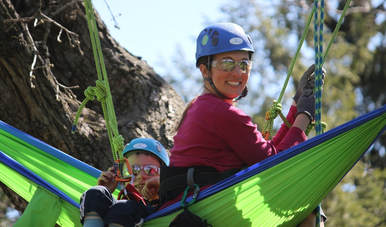 During one of our climbs last May, we had people from 7 years to 76 years of age in a tree at the same time. There was a family of 2 children, mom, dad, and grandfather who all had time on rope. There was a father and son as well as a mother and daughter climbing that day. Like most climbs, we also had a few siblings as well as a handful of single climbers. Growing up in a house of 6 boys, many of our back yard activities involved sports. That was a lot of fun; if you were the oldest. It was hard to get a fair game of 3-on-3 football going when dealing with an age span from 7 to 19 and height difference from 3 ½’ to 5 ½’. Gatherings with my brothers and their families these days presents us with an age span of 5 to 50. Probably the same as your family, we see the different age groups splintering off to play with each other. That all changes when Uncle Curt shows up and the ropes are set in the tree. Everyone comes wandering back together for an afternoon of family fun. Individual Challenge, Joint Experience With tree climbing, each person climbs on their own rope. There could be twelve of us in the tree at any given time. While climbing the tree together, you get to face your own challenges, set your own goals, and have your own successes. And I get to have mine. At the multi-generational climb in May, a fear of heights was the challenge for two of the climbers. One successfully reached the first branch at 15 feet above the ground. The other was able to push until she could sit on a branch 25 feet up. One person was challenged with the technique, yet he persisted and reached his goal of climbing high enough to see out across the park. With the father and son, we were able to help the young boy reach the height he was most comfortable at. Once he returned closer to the ground, he repeated the ascent process. When he discovered the sensation of being swung through the air, we could not swing him high enough! Once the father realized the son was able to climb on his own, dad was able to focus inward and head for the top of the tree. Pushing himself ever higher, he too reached his goal as he stood on a branch near the top of the tree. Building Bonds A young girl’s face glowed with excitement as she watched her parents and grandfather climbing the tree with her and her sister! Her lack of fear and inhibition led her to higher points in the tree, all the while encouraging her family to continue their journeys and join her. Three generations playing together. The mother and daughter were able to ascend ropes next to each other and approached the climb similar to a casual hike. The bond they shared was apparent in their conversation during their time together that morning. Two of the observing parents commented on how focused their children were while climbing, that they never asked for their electronic devices which were left back in the car. For those who had never visited the park we were climbing in that day, most were unaware that a river flows by only 30 feet from our climbing tree as it is screened by tall grass along the bank. With the elevated perspective, the river came into view for the climbers. At one point, all climbers were able to catch a glimpse of passing canoeists and shout out a cheerful greeting to the bewildered paddlers. I would have loved to seen the faces of the paddlers, or better yet, had their view of people hanging in the trees on a seemingly secluded stretch of the Fox River. While all of the climbers enjoyed the same tree and views of the river and park, they each came away with something completely different. Every ascent is a new venture, a new challenge, and an opportunity to reach a new goal. We spend the time together, yet it is your personal experience which provides the greatest impact and long-lasting memories. Afterwards, climbers often continue the conversation over lunch or on the ride home in order to share personal experiences, observations, and successes during their day in the trees. These kinds of climbs, with diverse groups and even my own brothers, nieces and nephews at a family gathering are what make me treasure activities like tree climbing. Activities that open up an experience that can be enjoyed by individuals, families, couples, friends, clubs, and a variety of groups or teams. The bond that is created is real. What diverse group are you part of that could benefit from being in a tree together?
0 Comments
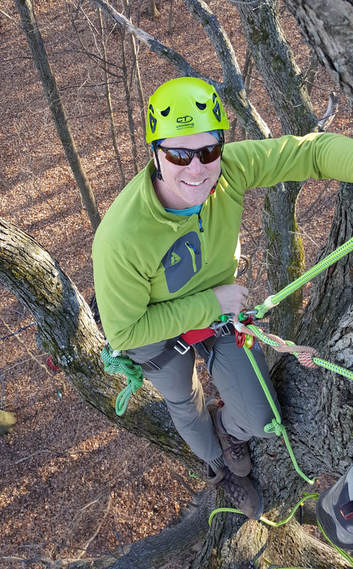 Do you often think back on your childhood with fond memories of seemingly endless summers being spent outside? Do you remember family vacations in National or State parks? Did you enjoy exploring the nearby woods? Did you have a favorite climbing tree? I remember the impact the Smoky Mountains had on me, with their ever changing shades of green fading to blue as the ridgetops seemed to pop up endlessly into the horizon. I can still picture the vast amount of sky surrounding us on an airboat ride through sawgrass marshes in the Everglades. Even with these neat adventures, no summer was complete without our family’s annual camping trips. A large part of who I am today was formed and influenced by these experiences, and possibly more so through my time simply playing outside and spending time in nature. Benefits of Being Outside Growing up, my 5 brothers and I spent most summer days outside. Even in the heat and humidity of southern Florida, we’d much rather be riding our bikes around the neighborhood, exploring the field behind our house, or hiking to the nearby lake to play along the shore and cool off in the water. We often pitched our tents in the backyard simply because we enjoyed the simplicity and freedom of spending time detached from the television and electronic distractions inside (I'm talking about the 1980’s, so think Atari and MTV). If it weren’t for my parents’ willingness to let us ‘rough’ it in the back yard and insistence that we get outside and play, I can only wonder where my life’s journey would have brought me to today. When we were younger, we knew that spending time outdoors was the key to a happy life! Countless studies support this notion, explaining how crucial outside free-play is for us and our children. Free-play allows us to foster our creativity and decision-making skills. Children, in particular, benefit as they are developing motor planning skills and trying to discover their interests. Studies have shown the benefits of spending time in nature is even greater than simply being outside. If you are one who enjoys hiking, camping, hunting, or canoeing, you are probably already aware of nature’s power to make you relax beyond how you feel when you take a walk around your neighborhood. Reduced stress, improved short-term memory, reduced inflammation, improved concentration, sharper thinking, immune system boosts, and improved mental health are some of the benefits that I have experienced firsthand. I wasn't too surprised when I began looking into and reading studies showing the relationship between children who spend less time in nature and the likelihood they experience attention disorders and depression. I have worked outside for a living most of my life. Even if your job has you indoors through the day, neither of us can escape the fact that we need time in nature and free-play. Making Time To Play Outside In the typical progression we call life, things get more complicated. A brief outline of my life is likely quite similar to yours. Now, enjoying our careers, it is quite easy to put in the extra hours. Home repairs pop up. There’s a lawn to mow, meals to make, dishes to clean, garden to weed, and so on. If you have kids, this list expands ten-fold, which can make it seem more difficult to send the kids outside for hours on end. Their schedules are filled with structured activities. You may face pressure from people who have different priorities and approaches for their kids. Kids aside, how about your own well-being? I am sure you still find time for fun, entertainment, and getting outside; but, what does your outside time look like these days? Does it most commonly consist of yard work, relaxing on the back patio, at the kids’ soccer game, or attending one of the many festivals throughout the summer? How much time do you spend in nature? Whatever happened to play time? Do you not have time for either anymore? While I do not play nor spend time in nature nearly as much as I did when I was younger, I know it should be a priority. If the opportunity escapes me for too long, I know it is imperative that I make time as it is as important as proper nutrition. Tree Time I had many favorite climbing trees when I was a kid. In Puerto Rico, there was a magnificent rubber tree (Ficus elastica) at the school playground whose aerial roots and large limbs demanded I swing in the canopy like Tarzan. There was also a rubber tree in our neighbor’s yard in Miami which catered to my later fantasy of living a life like I saw on Swiss Family Robinson. Those who have climbed in or even tended to the more moderate house plant, know how sticky the sap of a rubber tree is. I don’t think my mom ever quite understood that swinging through the trees relied heavily on having sap-layered hands and feet for grip. The sticky arms, legs, clothes and hair were a small price to pay for safety! I had a number of favorite climbing trees through the years. Every one of them provided me a place I could go to be alone. I could read a book, challenge my nerve, take a nap or simply lose myself in the serenity of the treetop. Even today, the benefits I receive from tree climbing often exceed that of other activities primarily because I am outside, breathing fresh air and inhaling the essential oils and compounds emitted by the trees and other components of the natural environment. The further away from concrete & asphalt and the larger the forest ecosystem the tree is growing in, the greater the effect. The climbing process itself heightens your senses and has a profound impact on your brain. You will feel energized once your feet leave the ground, yet you will find peace when you sit back and take in the views. Negative emotions, anxiety and stress will fade away, ushering in positive emotions and a boost in self-confidence and creativity. Feel Better. Be Happy. As much as I love hiking and playing in my gardens, much of my free-play during the summer is climbing trees for fun. Even though I can get in a personal climb during some of my work days, it is the climbing I do outside of work which impacts me the most. There is no right or wrong way to climb a specific tree, which means you are free to explore as you desire that particular day. One rule: stay tied in on rope at all times…the rest you just make up as you go. Nothing compares to how I feel when I am playing out in the woods, high in a tree. Everything comes into balance. Physically, mentally, emotionally. For me it is climbing trees. For you it may be hiking. Don’t wait for a doctor to prescribe it to you. Spend a few hours playing in nature this weekend. We were right all along…playing outside is key to a happy life! 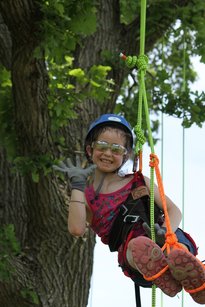 Running a climb at Strawberry Fest in Cedarburg, I had a mother thank me for providing the opportunity for her son to try tree climbing. The other activities were fun and enticing, but she was moved by the opportunity to give her son not only a unique experience, but an activity which required him to exert physical energy and challenge him mentally. Something that bumper boats or a train ride could not provide. I am positive that day will last in his memory for weeks and months because of the extraordinary way climbing allowed him to approach a challenge, problem solve, and achieve success all under his own abilities. Why This Experience Is Different Than Others There are lots of activities and events you can choose for your kids and your family in the summer. But not all of them are able to both excite and challenge young people the way tree climbing does. When you are standing on the ground, our explanation of the climbing process is quite simple and easy to follow. As soon as you are clipped on rope and sitting in your saddle with feet off the ground, everything changes. By entering the three dimensional realm above the ground, your sense of balance and stability is uprooted and causes a flush of hormones and adrenaline to cloud your thinking. Adventure and Experiential Education opportunities provide measurable benefits which is why they are a part of some of the most successful education programs around the world. With the developing minds and bodies of younger climbers, experiences such as tree climbing have the ability to greatly enhance their cognitive development. We open our climbs to children at 7 years of age and older. Patience Is The Key Of course we all want to see our children and students succeed. So much so that when we see them struggle, we are quick to offer advice and guidance. Unfortunately, by doing so, we are actually doing them an injustice. All too often, well-meaning bystanders, parents and teachers undermine the benefits by taking the mental processing out of the picture. As we saw above, once on rope, the simple climbing process takes on a new level as the nervous system is energized. By the time I leave a climber to themselves to work on their technique and personal style, they have demonstrated the basic understanding. They still need time to work through things on their own and develop the muscle memory necessary to make progress. It is actually quite simple to derail this process. Tell them what to do. When a new climber pauses or processes slower through the steps than what an observer on the ground deems reasonable, it is common instinct for the observer to shout out the next step in the process. Unfortunately, that alone is enough to shut down many people's mental processing. Without the opportunity to think it through on their own or learn from personal trial and error, the powerful impact and benefit of learning the process on their own is lost. Why process when someone will just tell them what to do? Something Adults and Kids Can Both Enjoy The same holds true regardless of age. The young developing mind is greatly impacted, yet adults of all ages benefit. This is why I love to see parents climb with their children. Everyone is on the same level. You are having the same experience, yet learning and growing on a personal level. By its nature, tree climbing allows many people to be climbing at one time, yet each person is on their own rope, therefore facing their own challenges. Obviously the title of this article is tongue-in-cheek, but what better way to have your child engage in a fun, non-electronic activity while gaining tremendous benefits without being aware of it!? Better yet, join them! We tend to each climber we have on rope. What does that mean to you? A pretty inexpensive baby-sitter! You are free to climb away and sit in the top of the tree. It is quieter up there. Let us take care of the kids. 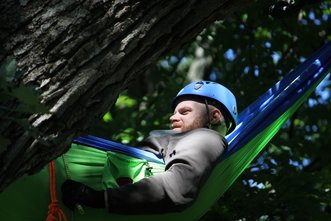 So much of our lives is about doing things faster and more efficiently. We run around like we are in a race to do as much as we possibly can. In truth, we often run ourselves ragged. Can you relate? We understand the value of being able to do things quickly, but there is also tremendous value in slowing down. Have you ever noticed that each year goes by faster as you get older? As we age, our careers demand more time, we are running kids from one activity to the next, and we find ourselves rushing home from the gym to make dinner. Setting The Pace Tree climbing is an exciting and engaging way to slow down. The simple fact that it helps me focus inward and be mindful of my existence is what drives me into the trees on a regular basis. There was nothing quick about my first ascent into a tree on rope. It was a mature white oak on a beautiful estate in western Illinois. We were on site as the sun was rising, given we had numerous trees to tend to that day before our return back into St. Louis. Having my line set by my trainer, I suited up and began the arduous task of climbing up to the first branch. I was very much aware of my surroundings and progress during that first ascent. Having worked ground support on a climbing crew, I had watched in awe at the ease in which our climbing arborists moved through the trees. They made it look so much easier than what I was experiencing that morning. Finally being able to climb into the canopies of these majestic trees was one memory I doubt I'll ever forget; especially considering that my trainer had set my tie-in point to allow me to make a 20' swing to another branch. I gained the ability to explore the world of trees beyond what I had ever done as a kid. What a rush! Life By The Clock As rewarding and invigorating as that first climb was, it was also the beginning of my journey into climbing trees under the clock. Get up, get done, get down. Production tree care is extremely rewarding, but in order for any business to be profitable they must work efficiently and safely. This is true in many areas of our lives, and probably sounds familiar to you. After 20 years of climbing, I had conditioned my mindset to approach every climb with the view of how can I best access the tree and return to the ground within a reasonable time. My attention needed to be completely on the tasks at hand and the people and obstacles below. Of course you can steal a minute here and there to sit back and take in the view... like Clark Griswald taking a brief moment to enjoy the view of the Grand Canyon before rushing the family back in the car in National Lampoon's Vacation. Even when I climbed trees for fun, I had the learned tendency to perform as if I were being timed. Enjoying The Journey A couple years ago, I finally made the deliberate effort to enjoy the climb. Stop racing to the top. Take pause on occasion to take in the experience, the tree, the view. Like I did that very first time I climbed. These days, I get to help many people experience the excitement and beauty of climbing trees. We climb for many reasons and reap many benefits. One of these is to slow down and enjoy our time. Before a climber descends, I try to remember to have them pause and take in the distant view from where they sit. They worked hard to get to that point, and should enjoy their just reward of the views, which very few people will ever get. There are many things I love about my time in the trees. Making acquaintances with the ants, preying mantises, squirrels, orioles, hawks, and cicadas I encounter is as enjoyable as inspecting lichens, moss, tree seedlings, mistletoe, or Spanish moss. I often find myself within reach of the highest leaves of the tree or looking back down the living being I have scaled at its firm foothold, maintaining my connection to Earth. Try Slowing Down A Little Climbing trees is one way people are able to slow down and revisit the days of their childhood when days seemed to stretch on endlessly. Our Open and Private Climb events are designed to provide you this opportunity. Please treat yourself this year and make time to join us for one of our Open Climbs. Discover for yourself the power of “tree time.” 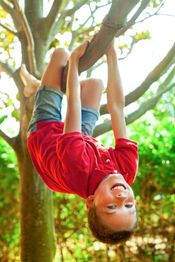 Source: Dmitry Naumov/Shutterstock Source: Dmitry Naumov/Shutterstock Researchers have measured the benefits of activities like tree climbing. They found that the perception of movement as you use your mind to navigate through the tree, and operate your hands and muscles while climbing, has tremendous effects on your cognitive abilities. The improvement in working memory is one of the skills they measured to have marked improvement. Read more at Time.com. For those who like a more technical discussion, read about it at Psychology Today. |
AuthorAs a G.O.T.C. Recognized Master Instructor & Facilitator, I.S.A. Board Certified Master Arborist, and T.C.I.A. Certified Treecare Safety Professional, Curt has spent over 30 years dedicated to the study and care of trees. Categories
All
Archives
April 2024
|
|

 RSS Feed
RSS Feed
